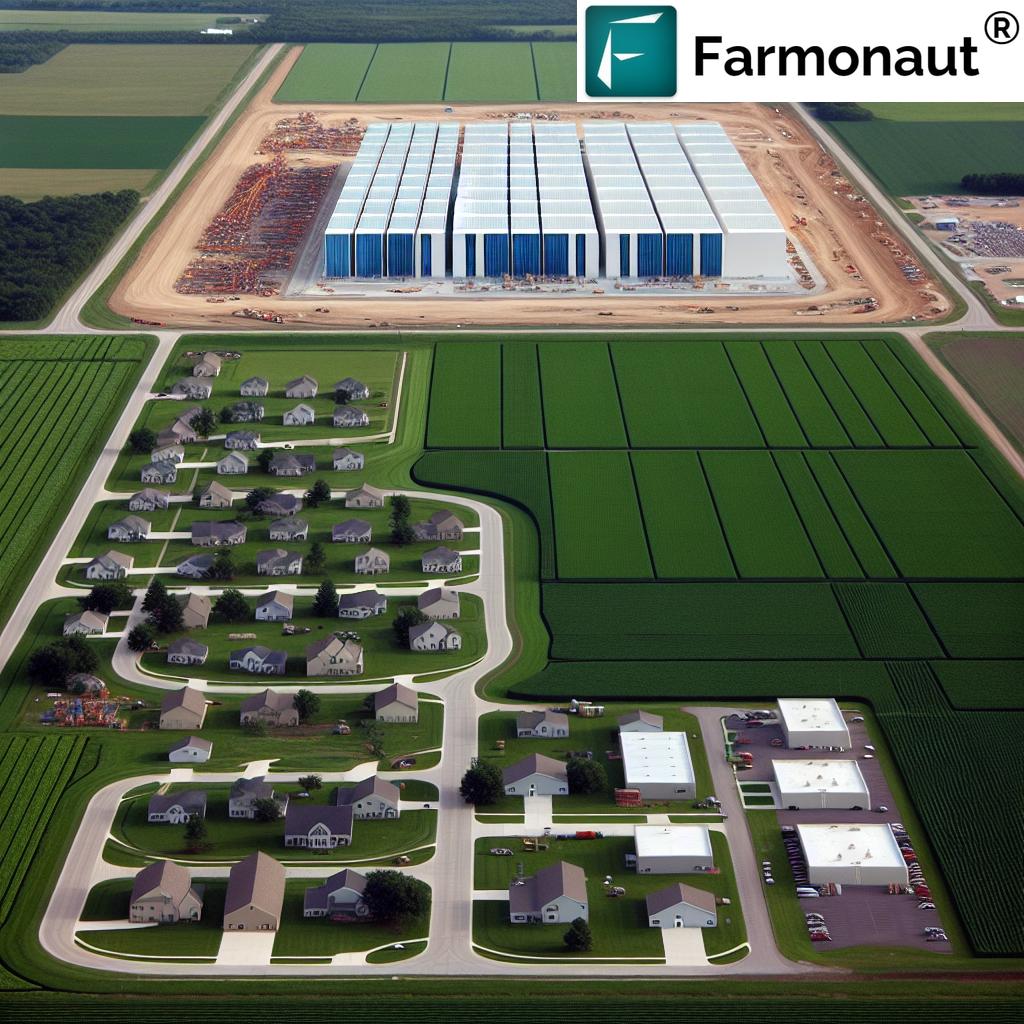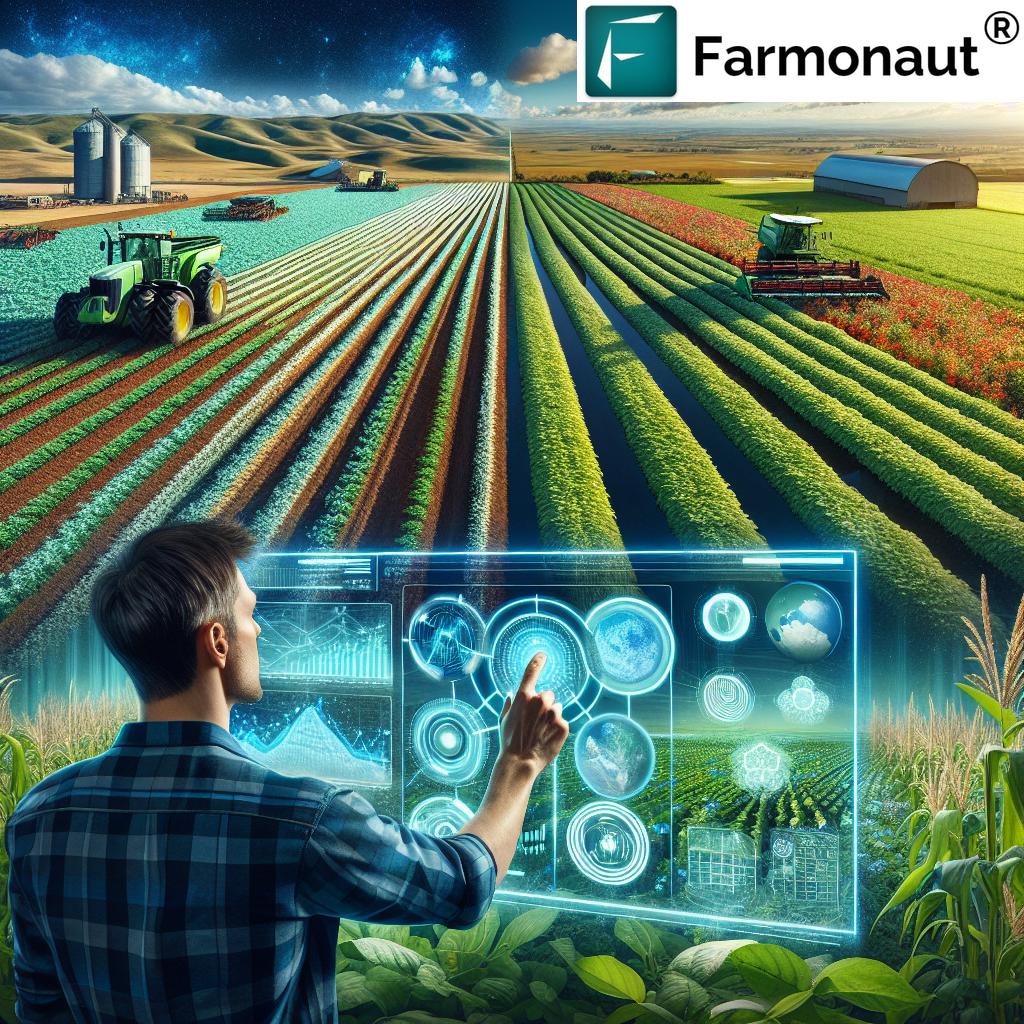Table of Contents
- Introduction: Agriculture of United States in 2025
- Agriculture Trivia 2025 #1
- Current State of Agriculture in United States
- Sustainability & Soil Health in U.S. Agriculture
- Climate Change Adaptation and Resilience
- Market Trends, Trade, and Supply Chain Resilience
- Technological Innovations Shaping the Future
- Comparative Trends Table: U.S. Agriculture 2025
- Policy and Support Systems for U.S. Farmers
- Farmonaut: Empowering Agricultural Advancements
- Agriculture Trivia 2025 #2
- The Future: 2025 and Beyond for U.S. Agriculture
- Farmonaut Subscriptions & App Links
- Frequently Asked Questions (FAQ)
Agriculture of United States: 2025 Trends & Updates
“By 2025, U.S. farms are projected to increase precision agriculture adoption by 35%, boosting efficiency and sustainability.”
Agricultural innovation keeps the agriculture of United States at the forefront of the global food system. As of 2025, the nation’s vast farmlands, data-driven technologies, and strategic policy create a fertile ground for sustainable growth, supply chain resilience, and market agility. In this blog post, we’ll uncover the major trends, sustainability efforts, innovation engines, climate adaptation strategies, and future-ready practices that make the agriculture sector a critical pillar of the U.S. economy and food security.
Let’s explore these 2025 developments in detail, providing actionable insights for farmers, agribusiness stakeholders, policymakers, and anyone interested in the agriculture updates shaping our world.
Current State of Agriculture in United States: 2025
The agriculture of United States remains a cornerstone of the nation‘s economy and food production system. The U.S. is regularly listed among the world’s largest producers and exporters of essential commodities like corn, soybeans, wheat, and cotton. By 2025, the sector displays both impressive technological advancements and evolving responses to persistent challenges such as climate variability, labor shortages, and market disruptions.
- Location Impact: States in the Midwest—often referred to as the “Corn Belt”—like Iowa, Illinois, Indiana, and Ohio, contribute disproportionately to national crop yields, particularly corn and soybeans.
- Farm Size & Output: U.S. farms range from family-run operations to large-scale agri-enterprises, and by 2025 are often characterized by extensive use of automation and digital farming systems.
- Export Leadership: The U.S. continues as a top exporter, cementing its role as a global agricultural powerhouse and a stabilizer in global food security.
Precision Agriculture: The Core of Modern U.S. Farming
Precision agriculture technologies have seen deep integration into all levels of production by 2025. Farmers now routinely employ:
- GPS-guided equipment for efficient planting and harvesting
- Automated irrigation systems that optimize water delivery based on soil and weather data
- Drone-based crop monitoring for real-time assessment of crop health, pest threats, and soil conditions
- AI-driven analytics that synthesize yields, weather, and molecular plant data for actionable insights
These innovations enhance productivity, optimize resource use, and lower input costs, all while reducing environmental footprints.
Commodities Driving the Sector
- Corn: The largest crop in terms of acreage and value, with new pest-resistant and drought-tolerant varieties boosting overall yields.
- Soybeans and Wheat: Remain staple crops, with soybeans particularly benefiting from export demand in Asia.
- Cotton: Innovations in genetic engineering and water-saving irrigation continue to reduce environmental impact.
- Specialty Crops: Fruits, nuts, and vegetables—especially in California and Florida—see growth due to rising consumer demands for fresh and organic produce.
Sustainability and Soil Health: Practicing Environmental Stewardship
Sustainable agriculture is a top priority for U.S. farmers as 2025 progresses. Practices that prioritize soil health, carbon sequestration, and ecosystem function are moving from niche to mainstream, supported by federal programs, private efforts, and market incentives.
-
Regenerative Techniques
- Cover cropping: Growing non-cash crops (clover, radishes, vetch) to protect soils, enhance organic matter, and reduce erosion between main crop cycles.
- Reduced tillage and crop rotation: Limiting soil disturbance and swapping crops annually, which disrupts pest life cycles and preserves soil structure.
- Organic amendments and compost: Adding carbon-rich material to boost microbial activity and water retention.
-
Soil Management Programs
- Federal conservation programs: Initiatives from USDA’s NRCS incentivize adoption of sustainable soil and water management.
- Localized initiatives: Midwest “Corn Belt” states with extremely fertile black soils (derived from glacial material and high organic matter) are adopting cutting-edge practices to protect their rich natural resources.
The Midwest Corn Belt (Iowa, Illinois, Indiana, Ohio, and neighboring states) serves as the exemplary model for high-yield, environmentally balanced farming—balancing the high demand for output with sustainability.
Reducing Nutrient Runoff: Protecting Waterways and the Gulf of Mexico
Initiatives focus on minimizing loss of nitrogen and phosphorous—key contributors to waterways pollution and the hypoxic “dead zone” in the Gulf of Mexico. This not only protects environmental health but safeguards future agricultural productivity.
- Example: On-farm buffer strips, constructed wetlands, and smart irrigation are increasingly deployed throughout the “Corn Belt” to reduce negative water quality impacts.
Organic & Biodynamic Farming on the Rise
Accelerator trends for organic and sustainably produced foods (particularly in California’s specialty crops and wine sector) cater to evolving consumer preferences and provide premium pricing opportunities for farmers.
Climate Change Adaptation and Resilience: Facing Environmental Challenges
Climate change and increasing variability in weather patterns necessitate adaptive strategies in agriculture of United States. The 2025 landscape is defined by investments in adaptive breeding, risk management, and technology-oriented water stewardship.
- Drought & Flood Management: Drought-resistant crop varieties, long-range weather forecasting, and improved irrigation technologies enable farmers to adapt quickly to droughts, floods, and shifting growing seasons.
- Federal Risk Programs: Crop insurance and disaster relief initiatives provide financial protection against weather-induced losses.
- Carbon Sequestration: Farms implement carbon farming practices to increase resilience and qualify for emerging carbon markets—where they are paid to store carbon in soils and plants instead of releasing it to the atmosphere.
Enhanced decision-making is further supported by satellite-based and AI-powered tools for soil moisture monitoring, forecasting, and disaster preparedness.
Market Trends, Global Trade, and Supply Chain Resilience in U.S. Agriculture
Market dynamics in U.S. agriculture reflect both shifting global trade policies and domestic consumer trends. After disruptions during the 2020–2023 era, 2025 is focused on creating a more robust and flexible value chain.
- Trade Policy and Export Markets: U.S. agricultural exports face an evolving landscape based on trade agreements, tariffs, and changing geopolitical relationships. Global demand for American crops including soybeans, wheat, and cotton remains strong as nations strive to diversify their import sources.
- Supply Chain Investments: Federal policies continue to prioritize infrastructure upgrades like high-capacity rail, improved grain storage, and modernized ports to reduce transportation bottlenecks and post-harvest losses.
- Domestic Consumption Trends: Consumer demand is rapidly increasing for organic, regenerative, and sustainably certified foods, particularly in urban markets and among younger demographics.
- Crops Diversification: U.S. farmers are increasingly switching acreage to high-value specialty crops, led by market demand and supported by technical assistance and risk insurance programs.
Encouraging Niche Markets
- Organic certification and carbon footprint labeling open doors for differentiated market and premium pricing.
- Farmonaut’s traceability technologies (read more here) support robust tracking and transparency for farm products, supporting supply chain integrity from field to consumer.
Supply Chain Resilience: Learning from Recent Disruptions
The COVID-19 pandemic underscored the vulnerability of agricultural supply chains. As a result, 2025 strategies emphasize:
- Distribution network redundancy and diversification
- Adoption of blockchain for secure and transparent product traceability
- Near real-time synthetic risk analytics, enabled by AI-driven platforms and satellite monitoring
Technological Innovations Shaping the Future of Agriculture in the United States
Innovation continues to define U.S. agriculture competitiveness. 2025 sees an acceleration in the adoption of advanced technologies and digital tools that enhance productivity, reduce environmental impact, and support supply chain resilience.
- AI and Automation: Robust AI-driven systems analyze multispectral images, soil data, and weather forecasts, providing actionable advice for planting, fertilization, and harvesting. Drones and autonomous equipment have become standard in fields across the U.S.
- Biotechnology: Next-generation genetically engineered crops, with enhanced pest and disease resistance, improved nutrition, and stress adaptation, are routinely approved and adopted.
- Vertical Farming and Controlled-Environment Agriculture: Urban areas leverage these methods to produce local food, reduce emissions, and address “food deserts.”
- Remote Sensing & Satellite Tech: Real-time field insights delivered via satellite imaging empower even smallholder farmers and cooperatives. Our Farmonaut tools make these advanced analytics accessible, actionable, and cost-effective across the sector.
Smart Farming for Sustainability
Data-driven choices (e.g., precise irrigation schedules, targeted nutrient application) reduce overuse of inputs, lower costs, and diminish environmental footprints. The shift towards smart agriculture not only offers yield optimization but also aids in achieving broader sustainability and environmental goals.
- Soil moisture monitoring (with platforms like Farmonaut) equips farmers with hyperlocal recommendations for irrigation and nutrient management, maximizing both crop yields and resource conservation.
Comparative Trends Table: U.S. Agriculture 2025
| Trend Category | Trend Description | Estimated 2025 Value / Adoption Rate | % Change from 2020 | Projected Impact |
|---|---|---|---|---|
| Sustainability Practices | Adoption of regenerative farming, cover cropping, reduced tillage | Over 45% of U.S. farmland | +70% | Reduced soil erosion, improved soil health, lower environmental impact |
| Use of Agri-Tech | Integration of AI, drones, GPS, satellite, precision tools | 35% increase from 2020 adoption | +35% | Enhanced yields, reduced input costs, improved resource allocation |
| Climate Adaptation Strategies | Climate-resilient crop varieties, adaptive risk management | 60%+ farms implement such strategies | +40% | Stabilized production, drought/flood mitigation, food security |
| Crop Yields | Increased through genetics, precision input use | Up to 190 bu/acre for corn (national avg.) | +20% | Boosted national output, export competitiveness |
| Water Usage | Smart irrigation, soil moisture monitoring, drought tech | 25% water savings vs. 2020 | -25% | Resource conservation, improved water security |
| Food Security Initiatives | Federal, public-private programs for resilience, traceability, infrastructure | 95% population secure access to food | +8% | Enhanced national food security, international reliability |
Policy and Support Systems for U.S. Farmers
A network of federal and state programs underpins agricultural resilience, productivity, and environmental performance.
- Research & Extension: Land-grant universities, Extension services, and publicly-funded initiatives ensure up-to-date knowledge is continuously transferred to producers, supporting everything from advanced irrigation to cover cropping.
- Subsidies and Grants: Direct payments and incentive structures target both commodity stability and sustainable practice adoption.
- Carbon Sequestration Incentives: Increasingly, government programs encourage (and sometimes pay) farmers who adopt regenerative practices, prioritize carbon farming (see Farmonaut’s carbon footprinting solution), and contribute to climate-resilient food systems.
- Crop Insurance & Loan Support: Weather risk and new technical assistance options are now accessible via satellite-based verification tools (accessible via Farmonaut’s crop loan and insurance product), streamlining claims and financing.
Farmonaut: Satellite Technology Empowering Agriculture of United States
We at Farmonaut are dedicated to transforming agriculture in the United States of America and globally through advanced satellite technology. Our platform empowers farmers, businesses, and governments with real-time data and actionable insights that are critical for yield optimization, climate adaptation, and sustainable resource management.
Our Core Solutions for U.S. Agriculture 2025
-
Satellite-based Monitoring:
We leverage high-resolution, multispectral satellite imagery to monitor crop health (including NDVI), soil moisture, and field variability. This technology gives farmers a bird’s-eye view of their fields, enabling precise action to maximize yield and reduce losses. -
AI-based Advisory:
Our Jeevn AI system interprets satellite, weather, and field data to provide hyperlocal, seasonally relevant advice for planting, fertilization, irrigation, and risk mitigation decisions. -
Blockchain Traceability:
We offer blockchain-based solutions for tracking agricultural products from field to fork, supporting compliance, food safety, and transparent market access (see details). -
Fleet & Resource Management:
Users can optimize the deployment, safety, and maintenance of machinery and logistics assets, reducing overhead and enhancing operational efficiency (learn more). -
Environmental Impact Monitoring:
Track and report on-the-fly emissions and carbon footprints, supporting compliance and access to the new wave of green finance markets (details here). -
API Power:
Our open API (access here | developer docs) lets agribusinesses, researchers, and tech partners integrate Farmonaut’s satellite insights into their tools, apps, or decision dashboards.
Whether you’re an independent grower, corporate producer, government agency, or finance institution, our subscription-based service model scales to your needs—making actionable satellite intelligence affordable and accessible for all.
“Over 60% of American farmers plan to implement climate-adaptive crop varieties by 2025 to ensure food security.”
The Future: 2025 and Beyond for Agriculture in United States of America
As we look past 2025, the agriculture sector in the United States continues its journey at the intersection of tradition and innovation. Ongoing research and development, consumer-driven sustainability, and policy support all enhance the sector’s resilience and ability to address environmental, climate, and market-related challenges.
- Continuous Technological Evolution: Broader adoption of data-driven management, remote sensing, and AI-based advisory will unlock additional productivity and environmental benefits.
- Decentralized Food Systems: Growth in vertical farming and direct-to-consumer models will diversify and strengthen the U.S. food supply chain.
- Environmental and Social Responsibility: Pressure to reduce resource footprints, improve supply chain transparency, and foster carbon-negative agriculture will intensify.
- Global Leadership: The U.S. remains a model for regenerative practices, climate-resilient crops, and technological advancement—sharing learnings with the global South and trading partners.
For large-scale farm management and monitoring, our dedicated Farmonaut Agro-Admin App (read more) allows managers and agronomists to oversee multiple plots, automate tasking, and gain bird’s-eye analytics quickly—all from a mobile device or web dashboard.
Looking to optimize broadacre crop plantation or forest stands? We provide satellite-driven plantation and forestry analytics via our crop plantation and forest advisory tool, supporting sustainable management and biodiversity goals.
Farmonaut Subscriptions: Affordable Agri-Technology for Everyone
Our flexible subscription model provides access to the latest satellite and AI-driven decision tools for fields, fleets, and food product traceability—without hefty hardware or complex installations. Businesses, researchers, government agencies, and farmers all benefit from scalable, robust, and cost-effective agricultural intelligence.
Frequently Asked Questions (FAQ)
What are the top trends in agriculture in the United States for 2025?
Key trends include widespread adoption of precision agriculture technologies, investment in regenerative and sustainable farming practices, adaptation to climate change, market-driven diversification (including growth in organic and specialty crops), and robust supply chain modernization.
How are U.S. farmers dealing with climate change and variability?
By 2025, over 60% of American farmers are adopting climate-resilient crop varieties, smarter irrigation systems, and risk management programs. Many are also leveraging remote sensing, data analytics, and carbon farming techniques to build on-farm and systems-level resilience.
What role does technology play in modern U.S. agriculture?
Technology is central to increasing yields, reducing costs, and limiting environmental impact. Precision ag tools (GPS, AI, drones, satellite data), biotechnology, and advanced irrigation all contribute to smarter, more efficient, and more sustainable decision-making.
How does Farmonaut support U.S. agriculture?
We provide actionable, real-time satellite intelligence, AI-driven recommendations, blockchain traceability, and environmental monitoring tools. These are accessible via app, API, or web platforms—supporting everyone from smallholder farmers to large-scale enterprises and government institutions.
Can non-U.S. users leverage Farmonaut’s platform?
Absolutely! Our solutions apply to global agriculture, including other top producing regions such as the agriculture in the United Kingdom, and provide valuable benchmarks for emerging markets as well as established economies.
How can I get started with Farmonaut?
Download our app for Android or iOS, visit the web platform, or explore our API offering. Explore the subscriptions above to match the scale and scope of your agricultural operation!














